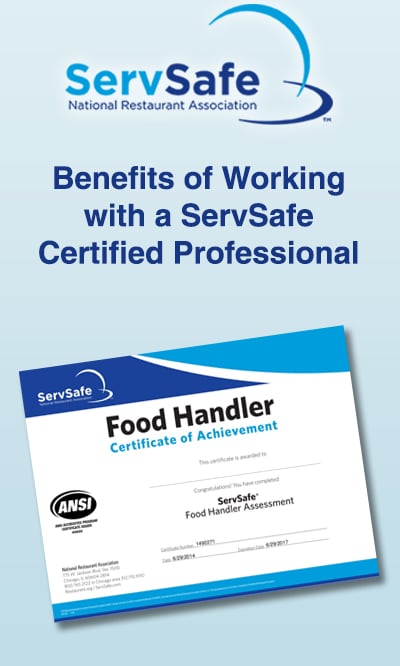Why Purchasing ServSafe Certifications Can Propel Your Food Service Career Forward
Why Purchasing ServSafe Certifications Can Propel Your Food Service Career Forward
Blog Article
Comprehensive Food Handlers Educating for Hygiene and Safety And Security
In today's quickly evolving food solution landscape, detailed food trainers training has become a vital component for guaranteeing health and security. By instilling essential practices connected to hand hygiene, food storage space, and hygiene, this training not only mitigates the danger of foodborne ailments however likewise reinforces conformity with regulatory requirements. The ramifications of such training expand beyond mere compliance; they discuss public health and consumer trust. Yet, the performance of these training programs can vary substantially. What factors really identify their success in promoting a society of safety and security?
Value of Food Security Training

In addition, food safety and security training aids to make sure that employees understand existing guidelines and standards, which are vital for keeping functional licenses and staying clear of costly penalties. Routine training sessions also act as a platform for enhancing ideal methods, thus lowering the chance of human error, which often works as a leading source of food contamination.
Furthermore, purchasing food security training can improve a facility's reputation, as clients significantly focus on eating experiences that reflect high safety standards. Such positive steps not only secure consumers but additionally add to the lasting success of food businesses. In recap, thorough food safety training is a vital aspect of food solution procedures, directly influencing both public health and wellness and company sustainability.
Trick Concepts of Health
Preserving high criteria of hygiene is vital in any food dealing with environment to stop contamination and make certain the safety of consumers. The essential principles of health include several essential methods that food trainers need to continually apply.
First, hand hygiene is extremely important; food trainers must clean their hands extensively with soap and water prior to and after dealing with food, along with after making use of the toilet or touching any potentially infected surfaces. Devices and surface areas must be consistently cleaned up and sanitized to eliminate virus. This includes utensils, cutting boards, and kitchen counters, which should be maintained in a clean problem.


Proper food storage is likewise vital; raw foods need to be saved individually from prepared or ready-to-eat items to stay clear of cross-contamination. servsafe alcohol. Furthermore, maintaining appropriate temperature controls is essential; subject to spoiling products must be maintained secure temperature levels to prevent microbial development
Finally, individual hygiene can not be overlooked. Food trainers need to put on tidy clothing, use hair restraints, and avoid functioning when ill. By sticking to these crucial concepts of health, food handlers can dramatically decrease the threat of foodborne ailments and advertise a safer dining experience for all customers.
Typical Foodborne Ailments
Although several foodborne ailments can be prevented through correct hygiene and secure food dealing with practices, they remain a substantial public health and wellness worry. Foodborne microorganisms can result in a variety of diseases, varying from light gastrointestinal distress to severe difficulties and even death.
Usual foodborne illnesses include salmonellosis, triggered by Salmonella bacteria, commonly connected to undercooked fowl and eggs. One more common illness is listeriosis, connected with unpasteurized dairy products and ready-to-eat meats, which can be particularly harmful for expecting females and immunocompromised individuals. Norovirus, regularly contracted from infected food or surface areas, is recognized for its quick spread and capability to trigger episodes in common settings.
Escherichia coli (E. coli) infection, notably connected with undercooked hamburger and infected produce, can result in severe abdominal pains and kidney failing sometimes. In addition, Clostridium perfringens, usually located in large quantities of food that are improperly stored, can create gastrointestinal disorder with signs and symptoms showing up soon after usage.
Understanding these diseases is essential for food handlers, as awareness can dramatically reduce the danger of contamination and protect public health. Proper education and learning and training are essential parts in combating foodborne diseases.
Best Practices for Food Handling
Efficient food handling methods are crucial in stopping the spread of foodborne ailments. Appropriate hand you can try these out hygiene is vital; food trainers must clean their hands completely with soap and water prior to and after taking care of food, specifically raw meat or poultry. This basic activity significantly reduces the threat of cross-contamination
Secondly, preserving proper food storage temperature levels is critical. Subject to spoiling products ought to be kept at or below 40 ° F(4 ° C) to hinder bacterial growth. Additionally, cooked foods should be kept above 140 ° F(60 ° C) till offered.
Thirdly, ensuring cleanliness of surfaces and devices is important. Frequently sterilize counter tops, cutting boards, and tools, specifically after preparing raw foods. Use separate cutting boards for raw and ready-to-eat foods to better reduce contamination risks.
Moreover, when preparing food, it is necessary to follow the principle of "very first in, initially out" (FIFO) to manage supply effectively and lower putridity. Last but not least, always adhere and check out to foodstuff labels for risk-free cooking temperature levels and dealing with guidelines. By implementing these best techniques, food handlers can substantially enhance food safety and security and secure public health.
Executing a Safety And Security Culture
Creating a security society within a food handling environment is important for fostering a commitment to food safety among all team participants. This culture emphasizes the significance of food security as a common obligation, encouraging staff members to prioritize hygiene methods regularly.
To execute a safety society, companies need to start by providing comprehensive training that deals with food handling methods, potential hazards, and the significance of individual hygiene. Educating sessions should be interactive and tailored to the certain functions of team member, making certain importance and interaction.
In addition, leadership plays a critical role in developing this society. Administration needs to design safe techniques and interact the significance of food safety on a regular basis. Recognizing and rewarding staff members that maintain safety standards can additionally reinforce these actions.
Additionally, open communication networks must be established, enabling personnel to report safety concerns without anxiety of effect. Routine safety audits and comments sessions can help determine areas for improvement and enhance accountability.
Eventually, cultivating a safety and security society not only enhances compliance with food safety guidelines yet also safeguards public health and wellness, cultivates staff member spirits, and contributes to the total success of the food dealing with establishment.
Conclusion
In verdict, thorough food handlers training plays a critical role in promoting health and security within food solution establishments. By equipping employees with crucial understanding about food safety principles, common foodborne health problems, and ideal methods for managing food, such training dramatically lowers health risks. Moreover, fostering a culture of safety boosts the facility's track record and lines up with customer expectations for high safety and security standards, inevitably adding to public wellness protection and the total success of the food Click This Link solution industry.
In today's rapidly advancing food solution landscape, detailed food handlers training has actually arised as an important element for guaranteeing health and safety and security.Food safety training is critical for preserving high requirements in food handling and preparation, with studies showing that proper training can lower foodborne diseases by up to 30%. In summary, thorough food safety and security training is a vital aspect of food solution operations, directly impacting both public health and service sustainability.

Report this page